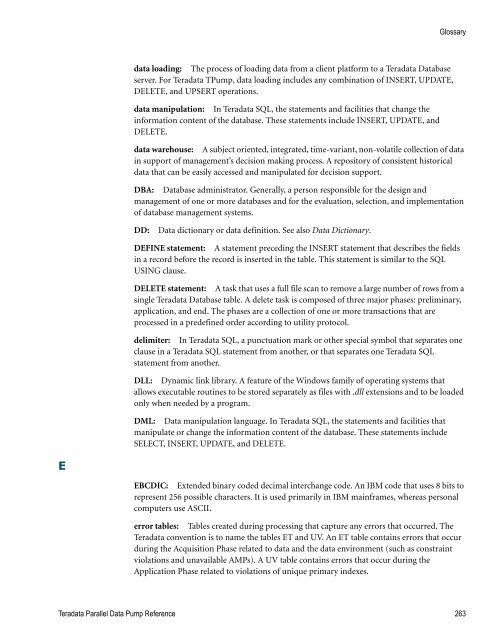Teradata Parallel Data Pump
Teradata Parallel Data Pump Reference - Teradata Developer ...
Teradata Parallel Data Pump Reference - Teradata Developer ...
- No tags were found...
Create successful ePaper yourself
Turn your PDF publications into a flip-book with our unique Google optimized e-Paper software.
Glossary<br />
data loading: The process of loading data from a client platform to a <strong>Teradata</strong> <strong>Data</strong>base<br />
server. For <strong>Teradata</strong> T<strong>Pump</strong>, data loading includes any combination of INSERT, UPDATE,<br />
DELETE, and UPSERT operations.<br />
data manipulation: In <strong>Teradata</strong> SQL, the statements and facilities that change the<br />
information content of the database. These statements include INSERT, UPDATE, and<br />
DELETE.<br />
data warehouse: A subject oriented, integrated, time-variant, non-volatile collection of data<br />
in support of management’s decision making process. A repository of consistent historical<br />
data that can be easily accessed and manipulated for decision support.<br />
DBA: <strong>Data</strong>base administrator. Generally, a person responsible for the design and<br />
management of one or more databases and for the evaluation, selection, and implementation<br />
of database management systems.<br />
DD:<br />
<strong>Data</strong> dictionary or data definition. See also <strong>Data</strong> Dictionary.<br />
DEFINE statement: A statement preceding the INSERT statement that describes the fields<br />
in a record before the record is inserted in the table. This statement is similar to the SQL<br />
USING clause.<br />
DELETE statement: A task that uses a full file scan to remove a large number of rows from a<br />
single <strong>Teradata</strong> <strong>Data</strong>base table. A delete task is composed of three major phases: preliminary,<br />
application, and end. The phases are a collection of one or more transactions that are<br />
processed in a predefined order according to utility protocol.<br />
delimiter: In <strong>Teradata</strong> SQL, a punctuation mark or other special symbol that separates one<br />
clause in a <strong>Teradata</strong> SQL statement from another, or that separates one <strong>Teradata</strong> SQL<br />
statement from another.<br />
DLL: Dynamic link library. A feature of the Windows family of operating systems that<br />
allows executable routines to be stored separately as files with .dll extensions and to be loaded<br />
only when needed by a program.<br />
DML: <strong>Data</strong> manipulation language. In <strong>Teradata</strong> SQL, the statements and facilities that<br />
manipulate or change the information content of the database. These statements include<br />
SELECT, INSERT, UPDATE, and DELETE.<br />
E<br />
EBCDIC: Extended binary coded decimal interchange code. An IBM code that uses 8 bits to<br />
represent 256 possible characters. It is used primarily in IBM mainframes, whereas personal<br />
computers use ASCII.<br />
error tables: Tables created during processing that capture any errors that occurred. The<br />
<strong>Teradata</strong> convention is to name the tables ET and UV. An ET table contains errors that occur<br />
during the Acquisition Phase related to data and the data environment (such as constraint<br />
violations and unavailable AMPs). A UV table contains errors that occur during the<br />
Application Phase related to violations of unique primary indexes.<br />
<strong>Teradata</strong> <strong>Parallel</strong> <strong>Data</strong> <strong>Pump</strong> Reference 263









